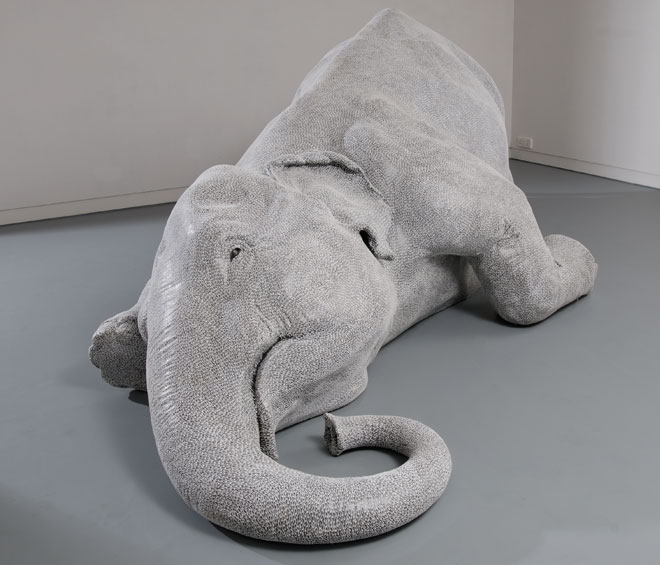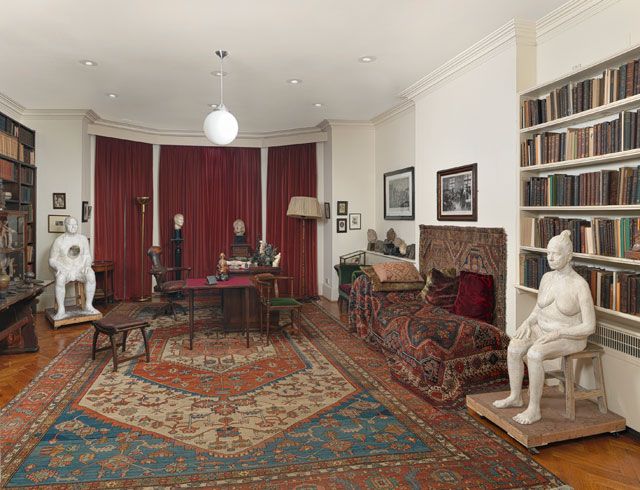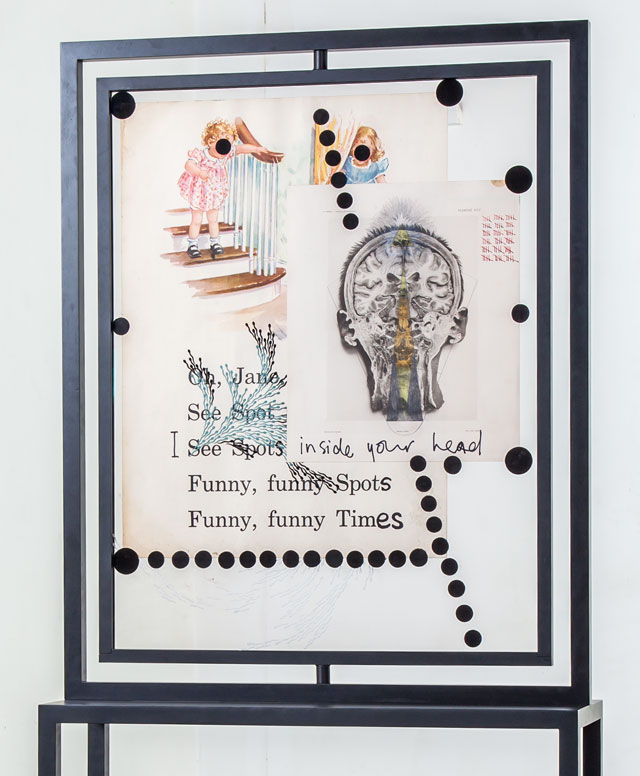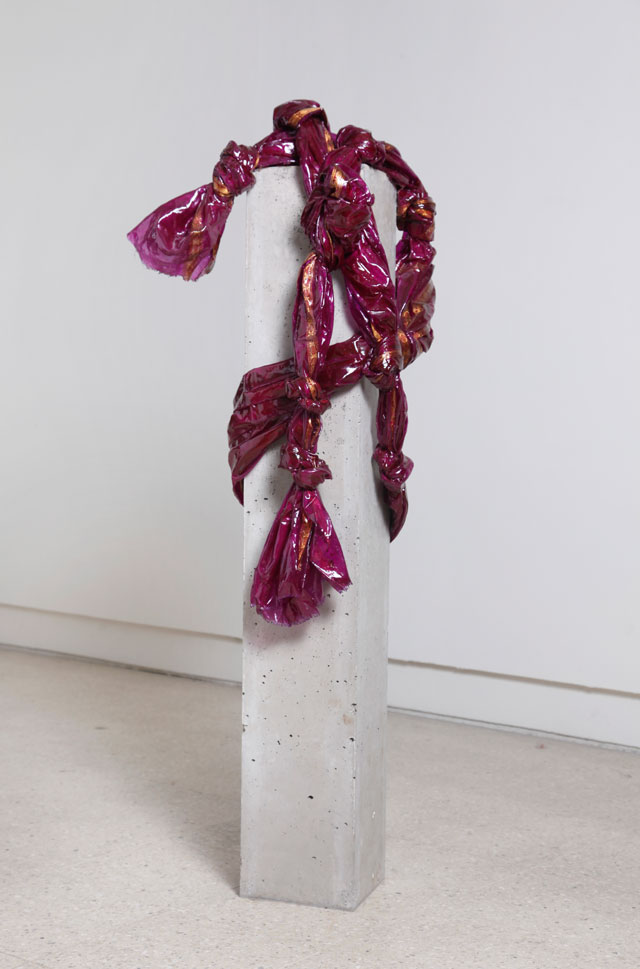
Bharti Kher. The skin speaks a language not its own, 2006. Courtesy the artist. Photograph: Pablo Bartholomew.
by SKYE ARUNDHATI THOMAS
When Bharti Kher’s The Skin Speaks a Language Not Its Own (2006) fetched $1.5m at a Sotheby’s auction in 2010, it broke the record for the most expensive sale at auction for a work by a contemporary female artist from India. The work, a 1:1 fibreglass replica of an elephant in an impossible position, is covered entirely in small grey velvet bindis, button-like and soft. On its surface, it may be read as a commentary on a kind of “Indianness”, but Kher’s work is too complex for such surface readings. She is often described as “India’s outsider artist”, yet this could not be farther from the truth. Kher is acutely aware of the ways in which narrative attaches itself to her and her work. “You know what, bring it on,” she says. “If you can get the moniker to run after you as an artist, I say more power to you. I think we can get as much help as we can. Let’s face it, the market is quite masculine already and the world is still reasonably patriarchal, and the art world is pretty much the same if not just a little bit better.”
,-2004.jpg)
Bharti Kher. Angel (from Hybrid series), 2004. Digital print on archival Hahnemuhle Photo Rag paper, 76.2 x 114.3 cm. Courtesy the artist and and Gallery SKE, Bangalore.
She is a realist, but not a cynic, and above all a mythologist – her practice is full of hybrid bodies; precious materials mixed together with cement and plastics as though they hold the same value; and processes of repetition, as epitomised by the bindi works, perhaps the only part of her practice that is immediately identifiable as hers. Kher possesses one of those rare minds that is always zooming out to consider the larger picture, and is able to work on several minute particulars at the same time. She is in precise control of every movement and machination of her practice. Her studio is certainly testament to this: set in a large building in the newbuild tech-city of Gurugram at the edge of New Delhi, it is surrounded by towering IT infrastructure and office complexes. Kher’s studio is made up of several floors, and could more accurately be described as a workshop, or a high-precision laboratory, with Kher its resident inventor and alchemist.
Studio International visited her at her studio to talk about her work.
Skye Arundhati Thomas: Maybe we should start with where we are – tell me a bit about your studio.
Bharti Kher: This building is a working analogy of how there are different parts to my practice, and how they all come together. Here, on this floor, is where the messy stuff happens; it’s where I break down and play with material. Downstairs, I have the bindi rooms, which is total abstraction, and where a part of my brain works to create a language through mark-making and repetition. I like to add and subtract things until they start to hold their own grace. In the way that a kitchen has many different things cooking at the same time, so does my studio – I like to keep things in layers.

Bharti Kher. Background: Father, 2016. Wax, plaster of Paris, wood, PVC, metal, 148 x 70 x 94 cm; Foreground: Mother, 2016. Plaster of Paris, wood, metal, 140 x 63 x 96 cm. Courtesy the artist and Hauser & Wirth. Photograph: Alex Delfanne.
And I am a great procrastinator; I can never make a decision about the final work. It’s always happening in bits. I’ll start something and, then, because I don’t want to deal with it, I’ll start the next thing, and because I don’t want to deal with those two things, I’ll start a third thing … Then I just wait until all three have filtered through my imagination, or my dreams. My practice is very slow, and I don’t push things over their limit; it’s mostly because they have been sitting around long enough that I finally reach there. I like to give the works their own space, and their own time to tell me what they are going to be.
SAT: A lot of the writing about your practice seems to conflate your person with the work, and I wonder how comfortable you are with that over-identification. To what extent is the work about you? Or do you just become a metaphor to give the work narrative?
BK: I think the question is twofold: how you are identified as a person, the artist, the woman, and, then, as an Indian. One is heavier than the other. Especially when, as an artist, you are identified with a country. When you look at the larger idea of India, of it being such a vast subcontinent, to then be able to carry a people, and their ways of thinking or seeing, I find that very difficult to negotiate, let alone to try and form a representation. Nationality has become a deeply contested space in political India today. Maybe the question is more about whether an artist’s life is truthful to the work. I think there is a natural phenomenology to the way I look at material or how I transform it. So if the workings of the hands are a truth about my body and mind, then, yes, the work is me.
,-2016.jpg)
Bharti Kher. The Chimera (1), 2016 (detail). Wax, concrete, plaster, hessian fibre, brass, 124.5 x 29 x 29 cm. Courtesy the artist and Hauser & Wirth. Photograph: Jeetin Jagdish.
It is also a process, and sometimes you are a subject of your own life, or a fallout of the ways in which you have been taught and conditioned. The way I learned about art-making was quite traditional: it was to take an object and exhaust it. You keep pushing it until you get to a point of obliteration, where the narrative is so exhausted that you arrive at a clean pitch, an abstraction. Then the work holds none of its previous qualities, but also all of them.
I’m constantly negating space, abstraction, time and form, and, by working through this negation – or the negative space around the object – I find the object itself. I like to break things. I break a lot of things, I break form … I think you have to, to understand form; you have to be willing to destroy it. I think the narrative is then everything and nothing. When I research a project, sometimes I can be there for weeks, finding stuff out, reading a lot, and when the work comes it’s everything of my research – but also none of it. Some pieces are just caressed, and it’s really like skin because, when you touch the work, it responds, and sometimes the colour will come on to your hands or other times you leave your print on the work. Most of all, I’m trying to push materials to do things that they don’t want to do. I want stone to have the softness of wood and I want concrete to look as if it has been petrified … I make narratives because I’m making metaphor constantly.

Bharti Kher. Links in a chain 1, 2016 (detail). Mixed media, 182 x 72.5 x 25 cm. Courtesy the artist and Hauser & Wirth, Photograph: Jeetin Jagdish.
SAT: The figures in the series Urban Goddesses are quite post-human or hybrid, or even cyborg. What shape do they take? Are they speculative, are they fictional, or are they metaphors?
BK: They are completely speculative, but they are also an amalgamation of many fictions and metaphors. They started out as the hybrid photographs in 2003, and I’ve continued from there – they are parts of real people, madeup parts, and sculpted bodies. I think my sculptures are supposed to be part truth, and part fiction. Part me, and part you. They travel through you. They are time travellers. They’re not sci-fi cyborg though; they feel of this Earth, very flesh and bones; they don’t feel of a future or even of the past. Neither are they perfect wax models that represent what you know. You don’t know my women. They are also failures, especially in the way that they embrace their idiosyncrasies and contradictions: such as the fact that they can’t move or that they are so heavy and stuck in a single motion. They have armour, but they don’t fight. There is an inherent vulnerability to the work.
SAT: Thinking about dialogues of vulnerability under a market lens, I’m not convinced. Is it even possible for works to truly fail or be vulnerable if they have to belong to a market economic?
BK: The two are not symbiotic. It’s not to say bad works don’t sell. They do. So I’m not sure whether that question is the right question, and I’m not sure it even makes a difference that a work is prescribed by such a definition. A practice is part of a longer trajectory – certain works are ready at certain times, and sometimes the works are not ready, or people are not ready for the work. Actually, I would say that the market is no indicator of an idea of the failure or the success of an artist. Of course, there are the artist’s artists, and the market often largely ignores them. There are no rules in this dance, and most of the time it makes no sense anyway.
But if we talk about the vulnerability of an artwork or the “failure project”, it makes me think of the Kantian idea that folly is an act of absolute freedom based on nothing but itself. Making art is itself a folly project. I come to the studio every day and I make things that no one really needs, but I keep coming back because this is where I make some kind of meaning for myself. Do I make it out to be bigger than it is? No, I concentrate it into something quite small, and I’m happy with that. It is rigorous, but it has to be made very simple. And to arrive at that simplicity involves a conceptual leap of faith.
SAT: I think the sari works are irresistible. Perhaps it is in the stilling of a fabric that is so fundamentally about movement, where the sculptures, like a liquid glass, still manage to contain that movement. Why the sari? And how did you develop this particular process?
BK: I was making a sculpture of a woman and I wanted to clothe her, so I tried dipping a skirt in plaster, but it didn’t work. So we started experimenting with cloth and resin. Soon I needed a bigger piece of fabric because I felt that I wanted gesture in form. And there it was right in front me, just waiting for me.

Bharti Kher. Portrait from memory I, 2012-13. Sari, resin, cement, 109 x 30 x 44 cm. Courtesy the artist, Photograph: Shankar Natarajan.
I got out my mother’s saris and my own, and I started crumpling them or leaving them in piles on the floor, which is how I made the first series – the mountains, which then became the pillars, and then the portrait pieces. When I started making these works I asked, who are these people and why do these gestures suit them? I was thinking about women that I know – and that these are portraits of them. Homages, even. You say liquid glass; I say amber – because I’m freezing moments in time. I think the material is not always the message, but what you do with it, and I think that they have become another material that I can add to this repertoire I have. They have also become a part of this larger language of the body that I keep returning to. I think materials can start their own conversations and carry with them residues that contain their own narratives. And within my studio, I’m interested in making those languages.
SAT: I keep thinking about the plinths in the sculpture series The Intermediaries – and if the plinth is taken as a stand-in for the body, how suddenly the sculptures become incredibly performative, just as the body sometimes is.
BK: I think The Intermediaries are a continuation of the hybrid works, and they are getting increasingly complex, and more irreverent and mad. What the plinths start to do is make the work more dynamic. I needed a surface that reflects back at you, but I also wanted to give them this royalty – and to create the space for a single unit to flourish. Casting the plates in brass was incredibly frustrating, but for me the challenge of material is also interesting. And to move the eye from cement to brass – it makes the cement soft.
,-2016.jpg)
Bharti Kher. The intermediaries (1), 2016. Wood, clay, 50 3/8 x 14 9/6 x 14 9/6 in. Courtesy the artist and Galerie Perrotin. Photograph: Bharti Kher Studio.
I also have some with wax and a thin layer of copper on the top – and these become so sweet, almost like crystallised, sugared cubes. You almost want to eat them. I like mixing materials in a way that sets off all your sensory responses. I want to use wood and wax and copper and plaster and clay and bring it all together – and then those five different languages speak together to create the sixth unknown language.
SAT: That’s interesting because so many parts of your practice seem to be about imprinting the body – and how the body can become material and vice versa.
BK: In the works that I made for the show This Breathing House, at the Freud Museum last year, I made casts of the face, and then covered them in wax. Wax is this amazing alchemical material, similar only to mercury. The wax analogy asks how two things can have different properties and yet still be the same. Wax when heated is one material, and when it cools it is another, but in all of its states, it never changes its principal property. So I start to cover the face I’ve casted, where the wax also acts like a protector of the work. The person I cast is locked inside, and is always going to be in there.
Plaster is a really interesting material – it’s the oldest casting material, used by the Egyptians 4,000 years ago. They used plaster to cast masks of the dead, masks they believed carried imprints of the soul. Plaster also enters the skin; it creates heat and opens up the pores of the skin to take its impression. A lot of people use latex now, which gives you perfect casts – but I wanted to take the essence of the person – it was this idea that they would somehow transfer a part of themselves into the cast. So I tell my models: “This is a process where you come into the studio and leave behind everything that you want to leave. Where only your cast knows what you leave behind.”